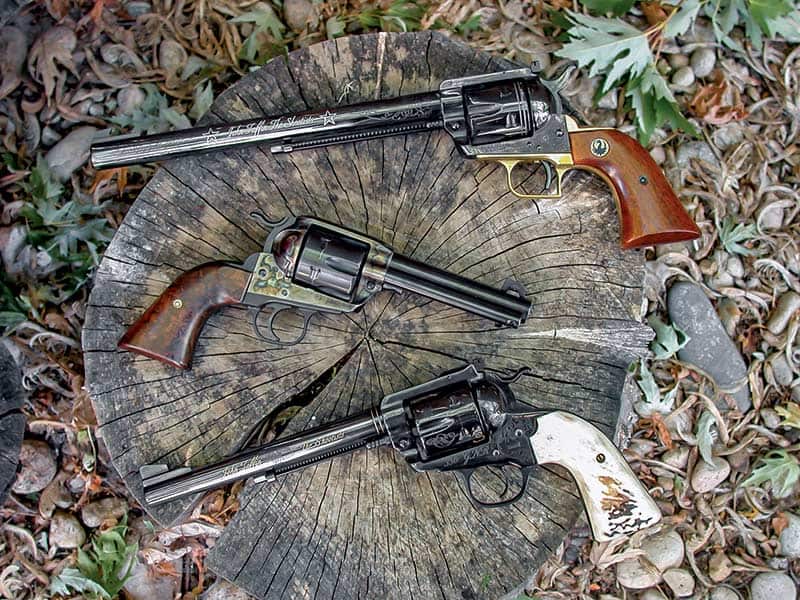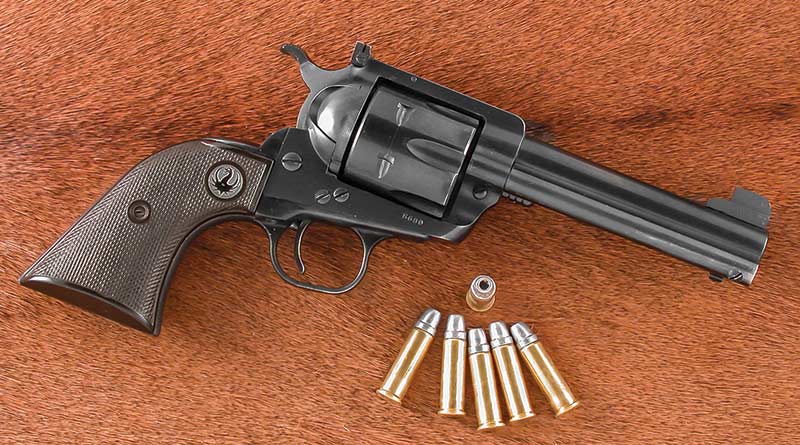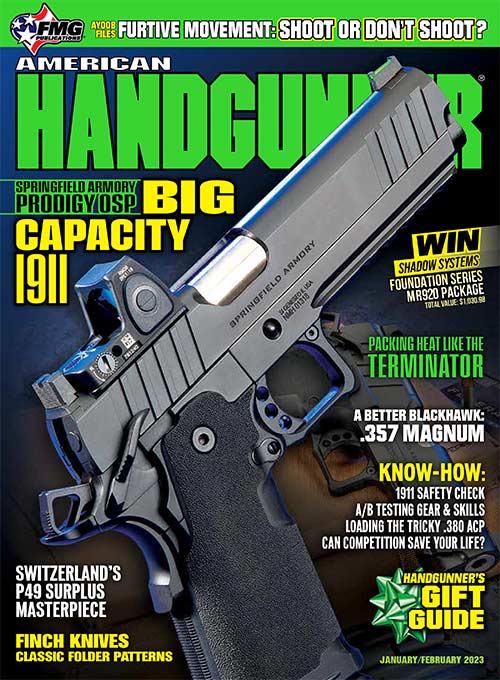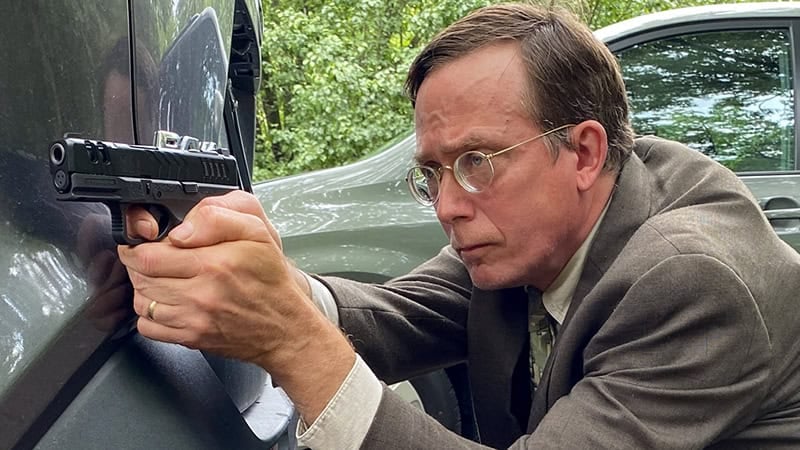The Sixgunner: Building A Better Blackhawk: .357 Magnum
Bill Ruger introduced his semi-automatic .22 pistol in 1949 and followed up with his .22 Single-Six in 1953. Two years later, in 1955, Ruger thoroughly modernized the centerfire single-action sixgun with the first Blackhawk. To arrive at the Blackhawk, Ruger increased the size of his Single-Six to duplicate the Colt Single Action Army, added a massive top-strap that enclosed a fully adjustable rear sight matched up with a ramp front sight and chambered it in the most powerful cartridge of the time, the .357 Magnum. To all this was added a virtually indestructible action.
When the existence of the .44 Magnum cartridge became known, three of the .357 Magnum Blackhawks in barrel lengths of 43/4″, 51/2″ and 71/2″ were converted to the new .44.
Elmer Keith told Ruger the frame was too small to handle the .44 Magnum. However, he would like to have the shorter barrel for use as a .44 Special. Ruger agreed to give it to him, but it got packed up with the other two to be shipped back to the factory. Ruger heeded Keith’s advice and proceeded to do more proof testing. Elmer proved to be right as one of the guns blew. The frame and cylinder size of the .357 Magnum was increased to better handle the .44 Magnum, and in 1956, Ruger’s .44 Magnum Blackhawk arrived.
.357 Dreams
Being a teenager at the time. I was mostly oblivious to all of this except for the original .357 Blackhawk. I was a junior in high school when I opened up the latest issue of Outdoor Life, and there was a full-sized picture of the new .357 Ruger Blackhawk. That picture was pinned above my bed and was the last thing I saw every night and the first thing I saw every morning. Someday, I would have one of these. In 1957 or early 1958, I acquired my first Ruger .357 Magnum Blackhawk.
Custom Thoughts
Then as now, the .357 Blackhawk is two sixguns depending upon one’s perspective. First, a Blackhawk, or any other Ruger for that matter, can be purchased and used for a lifetime just as it comes from the box. For more dedicated sixgunners, the Blackhawk is an excellent solid sixgun that can be improved to a Better Blackhawk to meet the wishes and desires of the original owner. I’ve used them extensively both ways.
My first .357 Blackhawk, now lovingly known as the Flat-Top Blackhawk, was in the original barrel length of 45/8″. Ruger soon followed with a 61/2″ version and then very rarely in the late 1950s with a 10″ .357 Blackhawk.
Ruger soon followed with a 61/2″ version and later with a rare 10″. Anyone who was a follower of the Colt Single Action noticed quickly something was amiss. Why the 61/2″ barrel length? Yes, this was a standard length of the Smith & Wesson .357 Magnum; however, speaking subjectively, it never appealed to me on the Blackhawk. The standard Colt SAA lengths were 43/4″, 51/2″ and 71/2″. Now I can forgive Ruger for the 1/8″ discrepancy in the shorter barrel, but why did he ignore the 51/2″ and 71/2″ and compromise with 61/2″?
When it comes to building a Better Blackhawk, I normally start with the original Three-Screw .357s, which were produced from 1955 to 1972. After that, the New Model .357 Blackhawk arrived and these have .44 Magnum-sized frames and cylinders, so I am partial to the smaller-sized originals.
Barrel Length Solutions
I am exceptionally fond of the original length of the .357 Blackhawk. The only change I have made on mine in nearly 60 years is to replace the sloping front sight with a flat black post, which is much easier for me to see. But I had to do something about that 61/2″ barrel length model. Two paths were chosen. One was an easy conversion of simply cutting the barrel back 1″ and remounting the front sight to come up with the Colt Artillery length barrel of 51/2″. As I’ve grown older, I’ve come to appreciate this length as only slightly more difficult to pack than the shorter barrel and only slightly less easy to shoot than the 71/2″ version.
I remember while still in my formative sixgunning years reading of Skeeter Skelton solving the “missing” 71/2″ model by cutting back an original 10″ barreled .357 Blackhawk. At the time, we did not know how rare the 10″ .357 Blackhawk was. To do such a thing today would certainly not be acceptable.
The alternative is to fit a new barrel; fortunately, it is relatively easy to find the right conversion barrel. During the heyday of long-range silhouetting, Ruger offered the Ruger .357 Maximum Blackhawk with a 101/2″ barrel. Many of these Maximums have been converted to larger calibers requiring a new barrel, which gives us a source for takeoff barrels.
I found four such barrels for use in building a Better Blackhawk. One was left at the original length and sent off to Gary Reeder attached to a .357 Blackhawk. Gary re-blued this Blackhawk as only he can while at the same time embellishing it with gold trim. I fitted it with a brass Ruger Super Blackhawk grip frame, and it is an exceptionally good shooting sixgun and companion to my original 10″ .357 Blackhawk.
About five years ago, the Ruger Collectors Association had a special run of 50 10″ .357 Blackhawks made up for members using the 50th Anniversary .357 New Model frame, which is the same size as the original. I was fortunate to come up with one of these. So, I now have three of these long-barreled Blackhawks for shooting pleasure. They are exceptionally accurate with all loads; however, I prefer 180- to 200-grain bullets, especially the latter. I bought an NEI four-cavity gas-checked #358.200 bullet mold from a reader, and these Blackhawks and that bullet are a marriage made in sixgunnin’ heaven.
More Better Blackhawks
The 101/2″ conversion took up one of the four barrels, leaving three. Starting with two .357 Blackhawks, one Old Model and one 50th Anniversary New Model, I turned everything over to my gunsmith Tom Cripe at Buckhorn Gun to be made into two Better Blackhawks. One would fill in the 71/2″ blank while the New Model would be used for something completely different.
When the original S&W .357 Magnum arrived in 1935, the first barrel length offered was 83/4″. This was a compromise between portability and being able to squeeze everything possible out of the new cartridge. If my duplication loads are any indication, those first loads exceeded 1,500 fps with a 158-grain bullet. The bullets proved to be too soft and leading soon appeared. The answer came with Ray Thompson’s gas-checked .357 Magnum bullet, the Lyman #358156GC.
Elmer Keith received one of the original long-barreled .357 Magnum Smiths, complained the barrel was too long for both packing and shooting and sent his back to the factory to be re-barreled to 61/2″. Meanwhile, it was soon discovered this longer barrel resulted in too much distance between the front and rear sights to allow it to be used in bullseye competition. I can’t believe anybody would actually have shot one of these in formal target competition. Nevertheless, that was the reason advanced, and the barrel length was cut back to 83/8″. Since I had plenty of barrel length to work with, I decided to go with the original length of 83/4″.
To finish these two projects, I had Tom polish off the warning label and re-blue the barrels before final fitting. The Maximum barrels use the longer ejector rod housings; however, I decided to stick with the standard-length housings which came on the .357 Blackhawks. This meant the original screw in the side of the barrel had to be plugged. The Maximum barrels are the heavy bull-barrel type, so they give these medium-frame .357 Magnums a distinctly muzzle-heavy feel.
Three of those barrels have now been put to project use, leaving one more in my parts box where it awaits a future project.

Get More Revolver Content Every Week!
Sign up for the Wheelgun Wednesday newsletter here:













